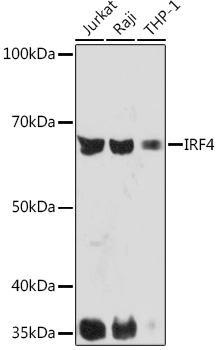Epigenetics & Nuclear Signaling Antibodies 5
Anti-IRF4 Antibody (CAB5215)
- SKU:
- CAB5215
- Product Type:
- Antibody
- Reactivity:
- Human
- Host Species:
- Rabbit
- Isotype:
- IgG
- Research Area:
- Epigenetics and Nuclear Signaling
Description
| Antibody Name: | Anti-IRF4 Antibody |
| Antibody SKU: | CAB5215 |
| Antibody Size: | 20uL, 50uL, 100uL |
| Application: | WB |
| Reactivity: | Human |
| Host Species: | Rabbit |
| Immunogen: | A synthesized peptide derived from human IRF4 |
| Application: | WB |
| Recommended Dilution: | WB 1:500 - 1:2000 |
| Reactivity: | Human |
| Positive Samples: | Jurkat, Raji, THP-1 |
| Immunogen: | A synthesized peptide derived from human IRF4 |
| Purification Method: | Affinity purification |
| Storage Buffer: | Store at -20'C. Avoid freeze / thaw cycles. Buffer: PBS with 0.02% sodium azide, 0.05% BSA, 50% glycerol, pH7.3. |
| Isotype: | IgG |
| Sequence: | Email for sequence |
| Gene ID: | 3662 |
| Uniprot: | Q15306 |
| Cellular Location: | |
| Calculated MW: | 52kDa |
| Observed MW: | 52KDa |
| Synonyms: | LSIRF, MUM1, NF-EM5, SHEP8 |
| Background: | The protein encoded by this gene belongs to the IRF (interferon regulatory factor) family of transcription factors, characterized by an unique tryptophan pentad repeat DNA-binding domain. The IRFs are important in the regulation of interferons in response to infection by virus, and in the regulation of interferon-inducible genes. This family member is lymphocyte specific and negatively regulates Toll-like-receptor (TLR) signaling that is central to the activation of innate and adaptive immune systems. A chromosomal translocation involving this gene and the IgH locus, t(6;14)(p25;q32), may be a cause of multiple myeloma. Alternatively spliced transcript variants have been found for this gene. [provided by RefSeq, Aug 2010] |
| UniProt Protein Function: | IRF4: Transcriptional activator. Binds to the interferon- stimulated response element (ISRE) of the MHC class I promoter. Binds the immunoglobulin lambda light chain enhancer, together with PU.1. Probably plays a role in ISRE-targeted signal transduction mechanisms specific to lymphoid cells. Interacts with SPIB and DEF6. Not induced by interferons. Lymphoid cells. Belongs to the IRF family. 2 isoforms of the human protein are produced by alternative splicing. |
| UniProt Protein Details: | Protein type:DNA-binding; Transcription factor; Oncoprotein Chromosomal Location of Human Ortholog: 6p25-p23 Cellular Component: nucleoplasm; membrane; cytoplasm; cytosol; nucleus Molecular Function:protein binding; sequence-specific DNA binding; protein-lysine N-methyltransferase activity; transcription factor binding; transcription factor activity Biological Process: transcription, DNA-dependent; T cell activation; cytokine and chemokine mediated signaling pathway; positive regulation of interleukin-2 biosynthetic process; positive regulation of transcription, DNA-dependent; regulation of T-helper cell differentiation; myeloid dendritic cell differentiation; defense response to protozoan; peptidyl-lysine methylation; positive regulation of interleukin-10 biosynthetic process; positive regulation of interleukin-4 biosynthetic process; positive regulation of interleukin-13 biosynthetic process; negative regulation of toll-like receptor signaling pathway; positive regulation of transcription from RNA polymerase II promoter; positive regulation of DNA binding Disease: Skin/hair/eye Pigmentation, Variation In, 8 |
| NCBI Summary: | The protein encoded by this gene belongs to the IRF (interferon regulatory factor) family of transcription factors, characterized by an unique tryptophan pentad repeat DNA-binding domain. The IRFs are important in the regulation of interferons in response to infection by virus, and in the regulation of interferon-inducible genes. This family member is lymphocyte specific and negatively regulates Toll-like-receptor (TLR) signaling that is central to the activation of innate and adaptive immune systems. A chromosomal translocation involving this gene and the IgH locus, t(6;14)(p25;q32), may be a cause of multiple myeloma. Alternatively spliced transcript variants have been found for this gene. [provided by RefSeq, Aug 2010] |
| UniProt Code: | Q15306 |
| NCBI GenInfo Identifier: | 2497445 |
| NCBI Gene ID: | 3662 |
| NCBI Accession: | Q15306.1 |
| UniProt Secondary Accession: | Q15306,Q5VUI7, Q99660, |
| UniProt Related Accession: | Q15306 |
| Molecular Weight: | 451 |
| NCBI Full Name: | Interferon regulatory factor 4 |
| NCBI Synonym Full Names: | interferon regulatory factor 4 |
| NCBI Official Symbol: | IRF4 |
| NCBI Official Synonym Symbols: | MUM1; LSIRF; SHEP8; NF-EM5 |
| NCBI Protein Information: | interferon regulatory factor 4; multiple myeloma oncogene 1; lymphocyte-specific interferon regulatory factor |
| UniProt Protein Name: | Interferon regulatory factor 4 |
| UniProt Synonym Protein Names: | Lymphocyte-specific interferon regulatory factor; LSIRF; Multiple myeloma oncogene 1; NF-EM5 |
| Protein Family: | Interferon regulatory factor |
| UniProt Gene Name: | IRF4 |
| UniProt Entry Name: | IRF4_HUMAN |







